Emergency communication refers to the communication means and methods needed for the extensive use of various communication resources to support rescues, including emergency rescues, and the necessary communication in the case of natural or manufactured emergencies. Because of the characteristics of disasters, making effective use of limited resources to provide the best communication services is a key problem. Unlike the traditional communication network, the emergency communication network is a complex network, and enables the implementation of emergency rescue activities and provides the primary conditions for the realization of emergency rescue functions. Its network structure has a significant impact on rescue efficiency. In different emergency situations, the demand for emergency communication is different, and the technical means used are different. Emergency communication mainly has the following characteristics: uncertainty of time and place应急通信[8,9,10]是指广泛使用各种通信资源支持救援(包括紧急救援)以及在自然或人为紧急情况下的必要通信所需的通信手段和方法。由于灾害的特点,有效利用有限的资源提供最佳的通信服务是一个关键问题。与传统通信网络不同,应急通信网络是一个复杂的网络,能够实施应急救援活动,为实现应急救援功能提供首要条件。其网络结构对救援效率有重大影响。在不同的紧急情况下,对应急通信的需求不同,使用的技术手段也不同。应急通信主要具有以下特点:时间和地点的不确定性; uncertainty of capacity demand容量需求的不确定性; high degree of timeliness of the emergency communication; complexity of the environment; uncertainty of the degree of damage to the communication network itself; and diversification of information.应急通信的及时性高;环境的复杂性;通信网络本身损坏程度的不确定性;以及信息的多样化。
- broadband-narrowband integration
- emergency communication network
- narrowband private network
- satellite network
- space-air-ground-sea integrated networks
1. Introduction简介
Before a disaster, the emergency communication network can combine the data obtained from different systems to provide a technical platform for early warning, and disaster reduction and prediction, so as to improve the ability to monitor, manage, and control accidents and disasters. After a disaster, the emergency communication network can quickly and reliably restore communication in the disaster area, assist users, be used to rescue workers, support disaster relief headquarters, and realize on-site personnel scheduling, on-site data transmission, and other functions, to promote emergency rescue work. This can provide valuable time and first-hand information for the rescue, so as to save more lives. With the frequent occurrence of natural disasters and the tightening of the international security situation, countries all over the world are strengthening and improving the construction of emergency communication systems and related technology research, and striving to deploy a more reliable and stable emergency communication network.灾害发生前,应急通信网络可以结合不同系统获得的数据,为预警、减灾和预测提供技术平台,从而提高事故灾害的监测、管理和控制能力。灾后,应急通信网络可以快速可靠地恢复灾区通信,协助用户,用于救援人员,支持救灾指挥部,并实现现场人员调度、现场数据传输等功能,促进应急救援工作。这可以为救援提供宝贵的时间和第一手信息,从而挽救更多生命。随着自然灾害频发和国际安全形势的收紧,世界各国都在加强和完善应急通信系统建设和相关技术研究,努力部署更加可靠稳定的应急通信网络。
-
Ability to work during both a disaster situation and at times of normality.能够在灾难情况下和正常情况下工作;
-
Dynamic expansion of the network to provide more coverage.动态扩展网络以提供更多覆盖范围;
-
Accurately transmit disaster information and provide comprehensive services.准确传输灾害信息,提供综合服务;
-
Have high reliability, high redundancy, high safety, and high anti-interference capabilities.具有高可靠性、高冗余、高安全性、高抗干扰能力。
2. Network Classification网络分类
应急通信网络为各类突发事件提供及时有效的通信保障,是综合应急保障体系的重要组成部分。对于任何国家来说,建立基于灾害通信骨干的有效应急通信是救灾的重要组成部分。应急通信网络根据不同的标准分为不同的类别。常用的分类标准如下: Emergency communication networks provide timely and effective communication support for all kinds of emergencies, and are an essential part of the comprehensive emergency support system. For any country, the establishment of effective emergency communication based on the disaster communication backbone is an important component of disaster relief. Emergency communication networks are divided into different categories according to different standards. The commonly used classification standards are as follows:-
According to the transmission medium, networks can be divided into wired communication networks and wireless communication networks.根据传输介质,网络可分为有线通信网络和无线通信网络。
-
According to the attributes, networks can be divided into public networks and private networks.
-
根据属性,网络可分为公网和专用网。
-
According to geographical classification, networks can be divided into local area networks (LANs), metropolitan area network (MANs), and wide area network (WANs).
-
根据地理分类,网络可分为局域网 (LAN)、城域网 (MAN) 和广域网 (WAN)。
2.1. 卫星网络
2.1. Satellite Networks
Satellite communication technology is a method of communication between two or more Earth stations using artificial Earth satellites as relay stations to forward radio waves. Satellite communication systems are usually classified according to the satellite orbit altitude, and can be divided into geosynchronous Earth orbit (卫星通信技术是两个或多个地球站之间的通信方法,使用人造地球卫星作为中继站来转发无线电波。卫星通信系统通常按卫星轨道高度分类,可分为地球同步轨道(GEO) satellites, medium Earth orbit ()卫星、中地球轨道(MEO) satellites, and low Earth orbit (LEO) satellites. )卫星和低地球轨道(LEO)卫星。
The satellite communication system is mainly composed of space, ground, and user segments, as shown in Figure
卫星通信系统主要由空间、地面和用户段组成,如图1. Space segment: with communication satellites as the main body, used for receiving and forwarding signals from satellite communication Earth stations, to achieve communication between Earth stations or between Earth stations and spacecraft. Ground segment: including satellite transponder, gateway station, Satellite Control Center (SCC), and Tracking, Telemetry, and Command station (TT&C), to realize communication between users. User segment: mainly composed of various terminal user devices, including Very Small Antenna Terminal (VSAT) stations, handheld terminals, and mobile terminals mounted on cars, ships, and planes, as well as various applications and services based on satellite communication.
所示。航天段:以通信卫星为主体,用于接收和转发来自卫星通信地面站的信号,实现地球站之间或地球站与航天器之间的通信。地面部分:包括卫星转发器,网关站,卫星控制中心(SCC)和跟踪,遥测和指挥站(TT&C),实现用户之间的通信。用户细分:主要由各种终端用户设备组成,包括安装在汽车、船舶、飞机上的甚小型天线终端(VSAT)站、手持终端和移动终端,以及基于卫星通信的各种应用和服务。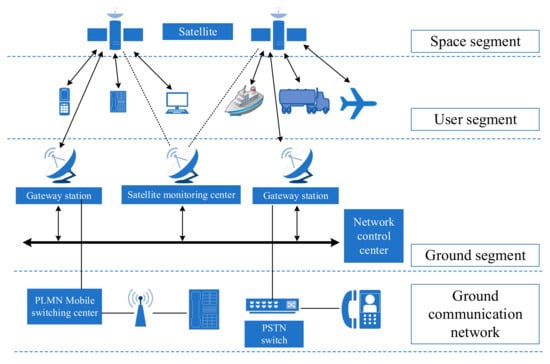
2.2. Ad Hoc Networks
2.2. 自组网络
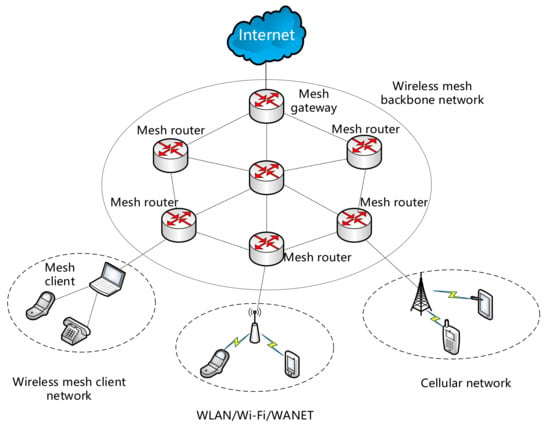
-
WMN is a multi-hop network that automatically selects the best path to avoid communication failure due to obstacles, so as to provide service transmission capability for users who are not within line-of-sight range.是一种多跳网络,自动选择最佳路径,避免因障碍物导致通信故障,从而为不在视线范围内的用户提供服务传输能力。
-
WMN has flexible and diverse networking modes, supports dynamic topology networking, provides effective networking capabilities for application scenarios with high mobility requirements, ensures the quality of connectivity among users, and expands network coverage.具有灵活多样的组网模式,支持动态拓扑组网,为高移动性需求的应用场景提供有效的组网能力,保证用户间连接质量,扩大网络覆盖范围。
-
WMN is capable of self-organizing, self-healing, and self-balancing, with strong network reliability.具有自组织、自愈、自平衡能力,网络可靠性强。
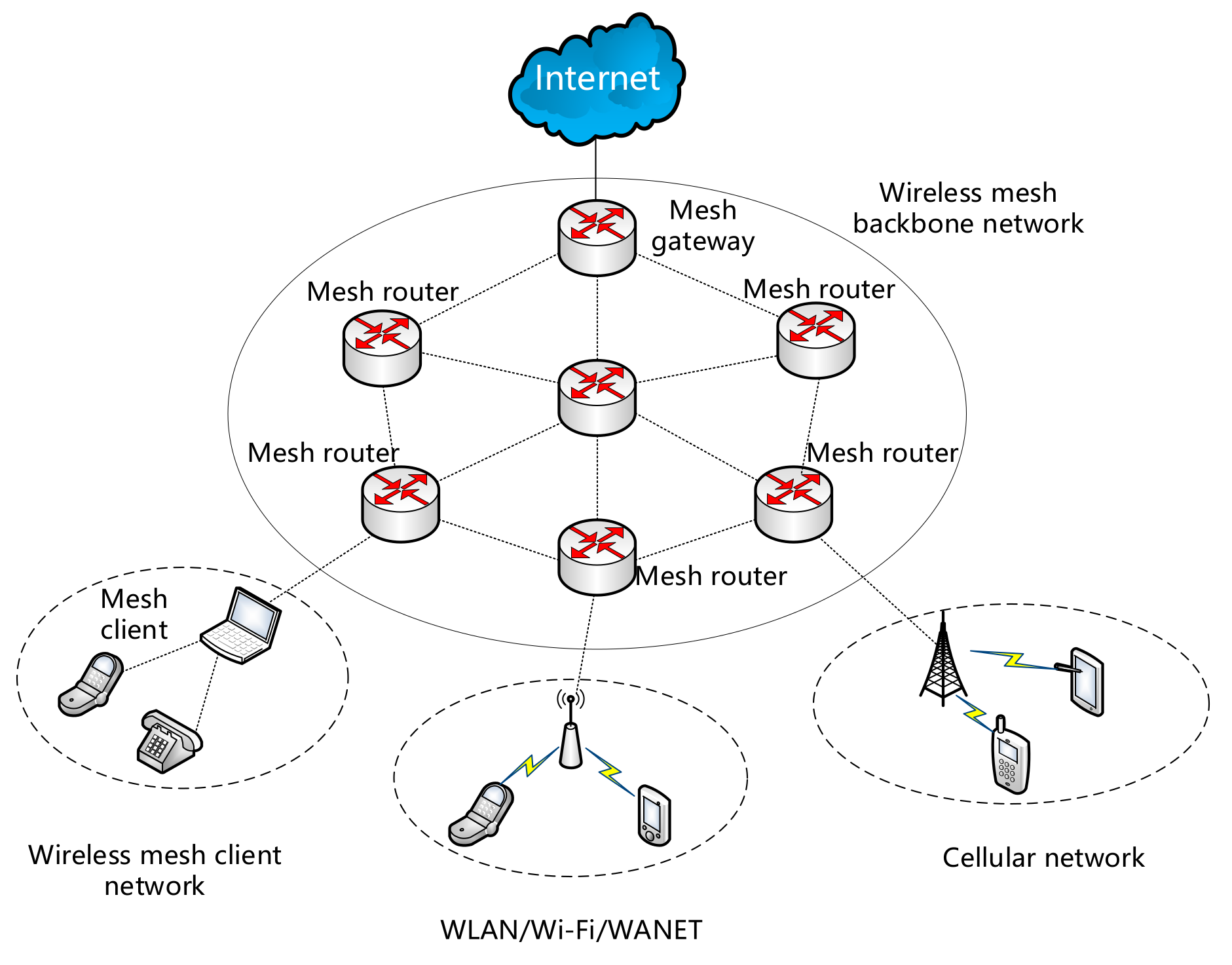 MANET是一种基于自组网模式的新型宽带WMN。其结构如图3所示。MANET利用移动终端的路由和转发功能,在没有基础设施的情况下进行通信,从而弥补了可用的网络通信基础设施的不足。马奈的特点是:
MANET是一种基于自组网模式的新型宽带WMN。其结构如图3所示。MANET利用移动终端的路由和转发功能,在没有基础设施的情况下进行通信,从而弥补了可用的网络通信基础设施的不足。马奈的特点是:
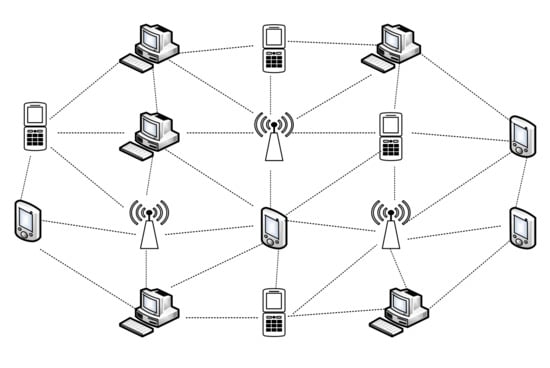
-
MANET is a distributed, multi-hop relay wireless broadband system without a center, and provides dynamic routing, strong damage resistance, and good scalability. Its network topology changes dynamically, and it internally uses its own routing protocol to complete wireless communication among nodes through wireless multi-hop forwarding.
-
MANET has the advantages of having a low deployment and maintenance cost, large coverage, high rate, strong network robustness and adaptability, and link self-sensing and self-healing. It can not only exist as an independent wireless self-organizing network, but also serve as an effective supplement and expansion of an existing heterogeneous network system.
-
MANET can be widely used in military communication private networks, public security private networks, emergency communication private networks, regional broadband private networks, and wireless monitoring private networks.
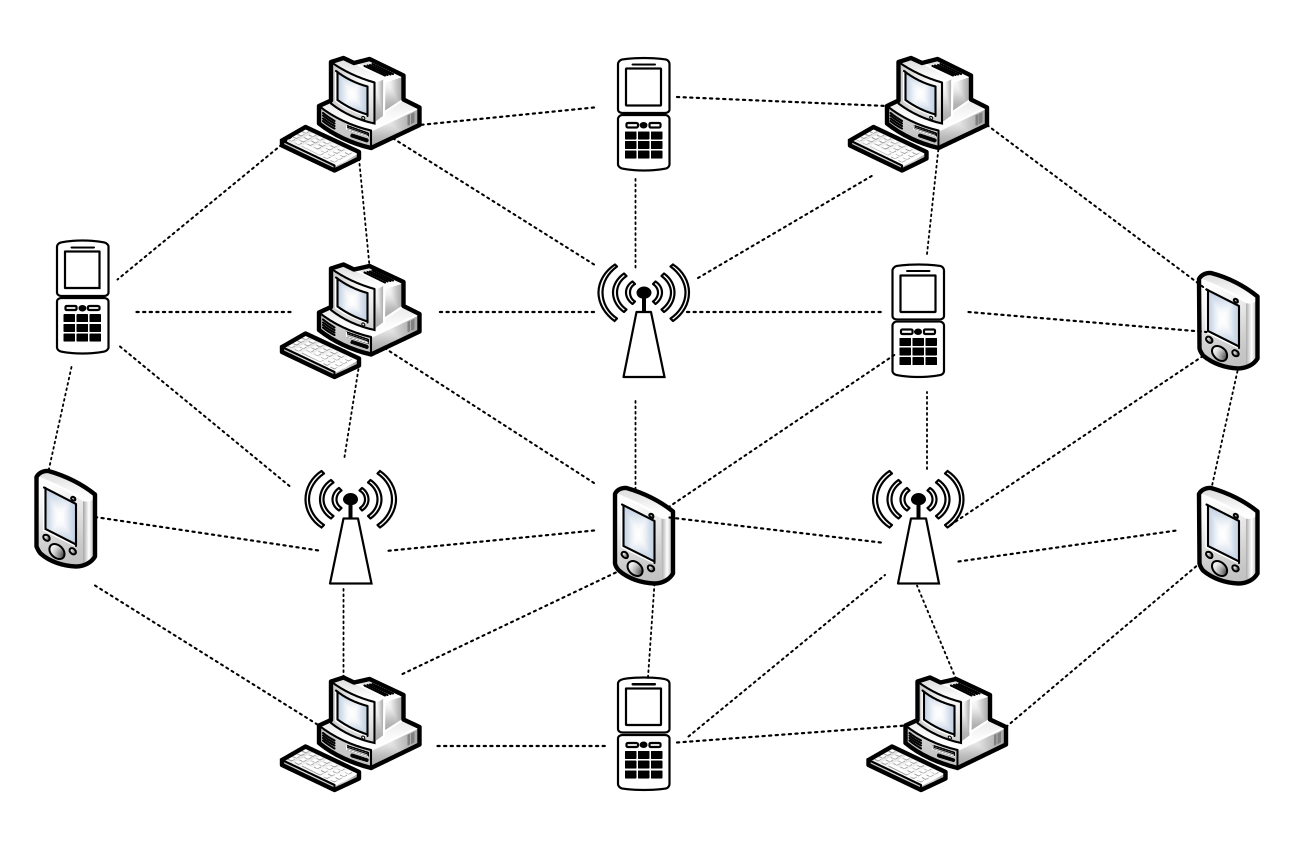
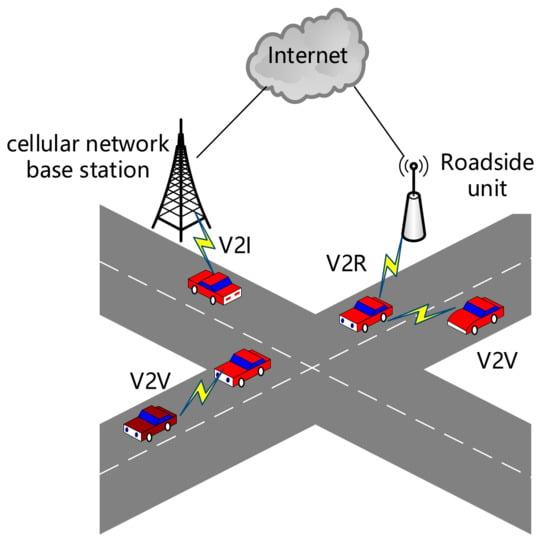
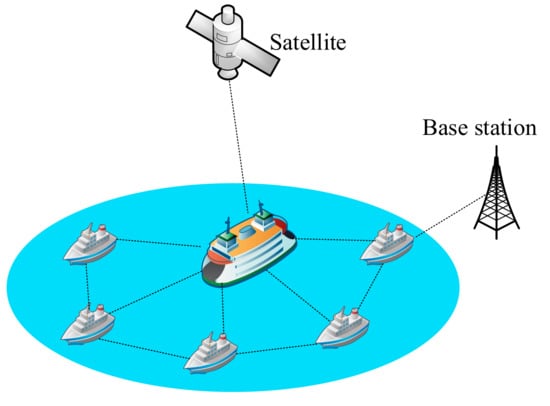
| Parameter | MANET | VANET | FANET | SANET |
|---|---|---|---|---|
| Number of nodes | high | high | low | low |
| Propagation model | on the ground | on the ground | in the air | on the sea |
| Topology | ad hoc and random | star with roadside infrastructure and ad hoc among vehicles | star and mesh (with base station, ad hoc among UAVs) | star and mesh (with base station, ad hoc among ships) |
| Topology change | dynamic, unpredictable, and low | average speed | fast | medium |
| Line of sight | not available for all cases | available in some cases | available in most cases | available in some cases |
| Power consumes | low | high | high for mini-UAV, small UAV not needed | high |
| Mobility | low | high | very high | medium |
| Mobility model | random | regular | regular under the condition | random |
| Main functionality | real-time communication | real-time communication | real-time communication | real-time communication |
| Computational power | limited | average | high | high |
| Density | low | high | very low | high |
| Localization | GPS | GPS, DGPS, AGPS | IMU, GPS, DGPS, AGPS | GPS, DGPS |
2.3. Cellular Networks
Cellular mobile communication adopts cellular wireless networking mode to connect terminals and network devices through wireless channels, so as to realize mutual communication between users. After developing the 1G, 2G, 3G, and 4G technologies, cellular mobile communication technology has entered the 5G era, and the development vision of 6G was proposed at the same time [87,88,89,90]. The development trend from 1G to 6G is shown in Figure 67. Modern mobile communication technology can be mainly divided into low frequency, medium frequency, high frequency, VHF, and UHF frequency bands. In these bands, technicians can connect terminal devices in the mobile communication network, using mobile station technology, base station technology, and mobile switching technology to meet people’s mobile communication needs. In emergency communication networks, the most significant advantage of mobile communication technology is the large communication distance, wide coverage area, and low cost. However, in the case of major natural disasters and public safety accidents, the public communication network may be interrupted and unavailable, and seriously affect the rescue effect.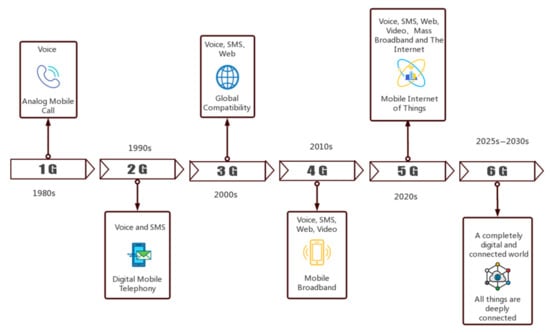
2.4. Wireless Private Networks
In the case of natural disasters and public security and other emergencies, due to the interruption of public communication networks or the inability to use public communication networks because of security reasons, it is often necessary to restore or supplement on-site communication in a short time using private networks. According to the technology used, emergency private wireless networks can be divided into five stages, namely, analogue cluster/conventional, narrowband digital cluster/conventional, 3G cluster, 4G broadband cluster, and 5G evolution. With digital wireless communication technology, digital cluster and conventional digital technology have been developed rapidly. PDT in China, Tetra and Digital Mobile Radio (DMR) in Europe, and P25 technology in the United States represent the narrowband digital cluster. As public network communication is evolving from 4G to 5G, digital cluster private networks are also gradually evolving in the direction of broadband multimedia [96]. 5G applications in the emergency industry will use 5G and artificial intelligence (AI) as the main approach and vigorously develop related applications. Wireless private networks, represented by digital trunking wireless communication systems, have the characteristics of high confidentiality, high reliability, and low service cost. They are mainly used in specific fields such as public security, fire protection, rescue services, and the petrochemical industry. Private network mobile communication systems include interphones, non-central digital systems, and trunking communication systems. An interphone is a two-way communication tool that is suitable for real-time communication, emergency dispatching, and collective cooperation. If natural disasters destroy the public network infrastructure, thereby preventing communication, the role of interphones will be more obvious. A trunked mobile system is a special dispatching communication system that is part of the advanced development stage of the private radio dispatching network. The system can dynamically, automatically, quickly, and optimally distribute the limited channels to all users of the system, so as to make maximum use of the channel frequency resources of the whole system. To date, an 800 MHz wireless trunking mobile communication system has been gradually established in various cities in China. Trunked mobile communication networks can be divided into two types: Public Access Mobile Radio (PAMR) networks and Private Mobile Radio (PMR) networks. To date, the commonly used standards in digital private communication include DMR, Digital Private Mobile Radio (DPMR), and PDT. The DMR standard adopts Time Division Multiple Access (TDMA) technology, supports single call, full call, group call, and selective call modes, and also supports direct mode communication without a base station. DPMA is a narrowband (6.25 KHz) Frequency Division Multiple Access (FDMA) technology that can provide various forms of voice/data applications. The PDT standard adopts TDMA multiple access mode and is based on the Chinese public security market. It not only supports low-cost single base station system communication, but can also achieve efficient regional coverage. While satisfying basic business requirements, it also adds innovative functions such as simulcast and dynamic frequency resource management. In earthquakes, wind disasters, fires, and other emergency events, the private communication network can quickly access the rescue dispatching platform, to realize flexible networking, efficient command and dispatching, high-quality voice and data transmission, and other functions. LTE is a long-term evolution technology based on 3GPP. LTE networking has the following advantages: it has a fast wireless network communication rate and high throughput, which can provide strong support for extensive services; with a slight delay, it can meet most application scenarios having high real-time requirements; and the LTE base station can be conveniently deployed and used to supplement the existing wireless communication infrastructure [97]. LTE is mainly applied in private networks, such as for emergency communication, smart construction sites, and forest fire prevention. In critical areas, the 4G-LTE broadband cluster is used for signal coverage, and the high bandwidth of the LTE system is used to realize video and high-speed data interaction and other services.3. Summary of Network Development Status
3.1. 370M Narrowband Private Networks
The 370M narrowband private network was the first narrowband wireless communication network used for emergency command in China. When major disasters occur, there are often “three noes”, of no power, no network, and no road. In this case, the narrowband private wireless network significantly improves the capability of ensuring communication. China adopted the domestic PDT standard with independent intellectual property rights to build a 370M emergency command wireless communication network, as well as a public network cluster and emergency communication equipment at the rescue site, to meet the demand of daily wireless command scheduling and sudden emergency communication, and finally connect the 370M PDT communication system of the national emergency management department to the Internet. The PDT communication system is deployed as a combination of fixed and mobile networks, with mobile base stations as the main part and fixed base stations as the auxiliary for digital cluster networking. It can be applied in fire protection, earthquake, and other fields to provide communication support for emergency rescue.3.2. Mobile Satellite Networks
The International Telecommunications Union (ITU) divides satellite communication services into three categories: fixed-satellite service (FSS), mobile satellite service (MSS), and broadcasting satellite service (BSS). The traditional emergency satellite communication is mainly an FSS system, which uses a C/Ku high orbit satellite to construct the VSAT satellite communication system. However, in recent years, the MSS system has played an increasingly important role in major natural disasters, especially within 72 h of the disaster. When the ground network cannot be used, the rescue organization needs to use the MSS system to understand the real-time messages in the disaster area, so as to organize effective rescue activities. At present, most communication satellites in the world are mainly 目前,世界上大多数通信卫星主要是GEO satellites, which have wide coverage and a relatively stable location. However, with the increasingly crowded orbital space and the development of cellular communication, multiple access, spot beam, and other small satellite technologies, LEO satellites have gradually been application in space-based communication systems; these satellites have short transmission delay, small path loss, and more effective frequency reuse. A number of countries have successively launched large-scale LEO satellite systems.卫星,覆盖范围广,位置相对稳定。然而,随着轨道空间日益拥挤以及蜂窝通信、多址、点波束等小卫星技术的发展,低地球轨道卫星已逐渐应用于天基通信系统;这些卫星具有传输延迟短、路径损耗小、频率重用更有效等特点。一些国家相继发射了大规模的低地球轨道卫星系统。 Inmarsat was the first global mobile service satellite communication system in the world. The user link uses the 国际海事卫星组织是世界上第一个全球移动服务卫星通信系统。用户链路使用L-band to provide low speed digital voice, data communication, facsimile, and telegraphy services. 波段提供低速数字语音、数据通信、传真和电报服务。Inmarsat’s first to fourth generation satellite user links all adopted the L-band, while the 的第一代至第四代卫星用户链路均采用L波段,而Inmarsat fifth-generation satellites use the Ka-band, based on 第五代卫星使用基于DVB-S2 technology, and support broadband services having uplink of 技术的Ka波段,并支持上行链路为5 Mbit/s and downlink of 和下行链路为50 Mbit/s.的宽带业务[100]。3.3. 混合网络
Iridium utilizes on-board processing, on-board switching, and interplanetary link technologies, and uses TD应急通信网络是典型的复杂网络,涉及多种通信技术。它们的网络组成是多种多样的,并且是动态变化的。WMA multiple access for direct communication between handheld terminals and satellites, providing users with voice, data, paging, fax, and other services. “Iridium NEXT” mainly aims at IP broadband networking and the scalability and upgrading of load capacity, which will enable it to meet the complex needs of future spatial information applications.N作为一种新型的自组织无线网络,不仅可以与卫星、短波等应急通信方式有效结合,还可以作为移动通信网络和城域网的延伸,提供更广泛的无线接入覆盖,全面提升应急通信质量。 Starlink adopts a new connection protocol that is more lightweight than IPv6 and supports P2P. It is a decentralized network similar to blockchain. Satellites can accurately understand the longitude and latitude of each user’s physical location and reasonably distribute their data links. Starlink’s second generation system will employ inter-satellite laser links to provide seamless network management and service continuity. Starlink users access the Internet by converting the satellite signal into a 目前,WMN已应用于消防、水利防洪、电力救援、铁路救援、海上执法、海洋监视评估、森林防火等领域。中国地震局[102]提出了一种基于卫星和WMN技术的地震应急场通信系统。通过灾区多跳网状网络、卫星通信车、后地面固定通信基站,实现了Wi-Fi signal through a MN与后方指挥中心的互联互通。对于煤矿应急通信系统,关超[103]提出了一种基于Wi-Fi router. The Oneweb system has set up more than 50 gateway stations around the world, and its user link adopts the Ku-band. The user terminal can be used as a local Internet access point, and users can access the Internet through 3G, MN的地下救灾通信系统。该系统以由多个网状接入点、路由器和网关构建的无线网状骨干网为网络架构,利用地下通信功能系统和地面指挥中心实现煤矿应急救灾,满足现代矿山需求。网状和LTE, Wi-Fi, or satellite links.混合组网因其组网灵活、网络鲁棒性好、无线网络带宽高、支持非视距通信、网络规模大等优点,被广泛应用于应急通信。 The BeiDou satellite system is an active satellite positioning and communication system independently developed by China. It is the third satellite navigation system covering the world after the Global Positioning System (GPS) of the United States and the Global Navigation Satellite System (G目前,应急通信行业的专网项目正逐步从窄带数字集群向LONASS) of Russia. BeiDou satellites can not only provide rapid positioning and timing services for ground users worldwide, but also enable short digital message communication, which is one of the means of ensuring communication in an emergency. The Hongyan global satellite constellation communication system is planned to be composed of 300 low orbit small satellites and a global data service processing center, with allE宽带集群转变,宽带-time two-way communication capability under complex terrain conditions. It will provide users with global real-time data communication and comprehensive information services. The Hongyan constellation will integrate a number of satellite application functions. Its satellite data acquisition function can realize large-scale regional information collection and meet the needs of monitoring data information transmission in the fields of oceanography, meteorology, transportation, environmental protection, geology, and disaster prevention and reduction. According to the existing information, it is expected that the system will include a communication network of 60 artificial satellites by 2023. By 2025, the second phase will be completed, and a mobile satellite communication and network access system having space-air-ground-sea integration will be built. 窄带融合也成为重要的发展方向。采用窄带集群系统实现全覆盖,实现广域语音通信,4G-LTE宽带集群增加关键区域范围。利用LThe Hongyun project is a “star chain plan” independently developed by China. It is expected that 156 satellites will be launched into orbit 1000 km above the ground. The project is committed to building a satellite-borne broadband global mobile Internet that can provide integrated services for communication, navigation, and remote sensing for all types of users around the world. Because of its extremely low communication delay, extremely high frequency reuse rate, and real global coverage, the Hongyun project can meet the needs of China, underdeveloped Internet areas, and large-scale user units to share broadband Internet access. At the same time, it can also meet the application requirements of high real-time information interaction, such as in emergency communication, sensor data acquisition, industrial Internet of Things, and remote control of unmanned equipment. The Tiantong-1 satellite mobile communication system is a satellite mobile communication system independently developed and constructed by China. It is also an important part of China’s space information infrastructure, and solves the problem of seamless signal coverage in a particularly complex environment. The Tiantong-1 01, Tiantong-1 02, and Tiantong-1 03 satellites were successfully launched in 2016, 2020, and 2021 respectively. After the Tiantong-1 03 satellite was launched into orbit, it was networked in orbit to the Tiantong-1 01 and Tiantong-1 02 satellites. The Tiantong-1 satellite mobile communication system will achieve regional coverage in the Asia-Pacific region. It has the advantages of strong reliability, strong real-time performance, strong confidentiality, wide coverage, and long communication distance. It can provide stable and reliable voice, short message, video, and other mobile communication services, and improve the service level of satellite communication and emergency communication support capacity. The Tiantong-1 satellite system is a narrowband mobile satellite communication system. In case of natural disasters, the emergency communication capability of Tiantong-1 can play a significant role.3.3. Hybrid Networks
Emergency communication networks are typical complex networks, involving a variety of communication technologies. Their network composition is diverse and changes dynamically. As a new type of self-organizing wireless network, WMN can not only effectively combine with emergency communication methods such as satellites and short-wave, but can also be used as an extension of mobile communication networks and metropolitan area networks to provide more extensive wireless access coverage and comprehensively improve the quality of emergency communication. Under 5系统的高带宽实现视频和高速数据业务。4G with high bandwidth and low delay, WMN has more technical advantages, improving the synthesis, application, and systematization. The unique advantages of the ad hoc network enable it to occupy a position in the field of emergency communication. In the future, ad hoc networks will have an ideal space for improvement in miniaturization and portability. In the application of emergency communication, the integration of mesh networks with other private network communication and satellite communication systems will also be the focus of future development. Future development will also include the integration of 5专网通信可以提供矿井全无线覆盖,实现语音、数据、视频网络的高带宽无线集成,为煤矿数字化提供无线平台。针对地震现场工作,中国地震局提出,通过在重灾区建设4G with satellite networks, 5G with UAV integration, and the space-ground convergence network.应急指挥调度系统,通过构建宽带应急集群专网系统,实现现场人员调度、实时视频传输、现场数据传输等功能,缓解临时通信终端问题[116]。3.4. 5G Networks
3.4. 5G 网络
5G network technology includes network slicing technology, ultra-dense heterogeneous network technology, and multi-access edge computing technology. In emergency rescue work, the network slicing technology can be used to realize the interconnection of various devices, thus comprehensively improving the efficiency of emergency rescue command and promoting the development of rescue work. With the support of 网络技术[117]包括网络切片技术、超密集异构网络技术和多接入边缘计算技术。在应急救援工作中,可以利用网络切片技术实现各种设备的互联互通,从而全面提高应急救援指挥效率,促进救援工作的发展[118]。在5G network technology, all regions need to speed up the construction of emergency rescue communication equipment, especially that used for the network control center, satellite ground station, and converged communication platform. At the same time, it is also necessary to use emergency communication equipment to expand network coverage and promote the development of emergency rescue work.4. Future Development Directions
With the rapid development of network technology and information technology, future emergency networks will develop in the direction of intelligence, integration, popularization, and low cost. This will mainly introduce network intelligence and integration, and lead to the development trend of space-air-ground-sea integration networks.
Due to limitations in the radio spectrum, service geographic coverage, and operating costs, 5G ground communication networks alone cannot provide high-quality and reliable services at any time and in any place. This is especially the case in remote areas such as oceans, forests, and deserts. In order to provide truly ubiquitous wireless communication services on a global scale, it is necessary to develop an integrated space-air-ground-sea network to achieve global connectivity. The rapid development of wireless, broadband, fusion, and three-dimensional network technology provides the construction foundation for the integration of the space-air-ground-sea network with information sharing, interconnection, and unified command. Integrated use of big data, cloud computing, AI, satellite communications, multimedia communications, mobile communications, and other advanced technologies, and integration of space-based, air-based, ground-based, and sea-based platforms, can be used to construct the space-air-ground-sea integrated emergency communication network architecture. This architecture can realize the overall emergency resource planning and collaborative services of multiple platforms. The network architecture is shown in Figure 7. The integrated space-air-ground-sea network is based on a ground network, extended by air-based and sea-based networks, and connected and supplemented by a space-based network; thus, it covers the natural space including space, the sky, the ground, and the ocean. The air-based network consists of satellites, which can be divided into GEO, MEO, and LEO satellites. The space-based network is composed of aerial platforms such as near-space airships, airplanes, UAVs, and hot-air balloons. The ground-based network is mainly composed of LANs and cellular mobile networks, including all wired and wireless network facilities on the ground. Currently, this mainly relies on 5G network technology. The sea-based network consists of coastal base stations, surface ships, buoys, etc.
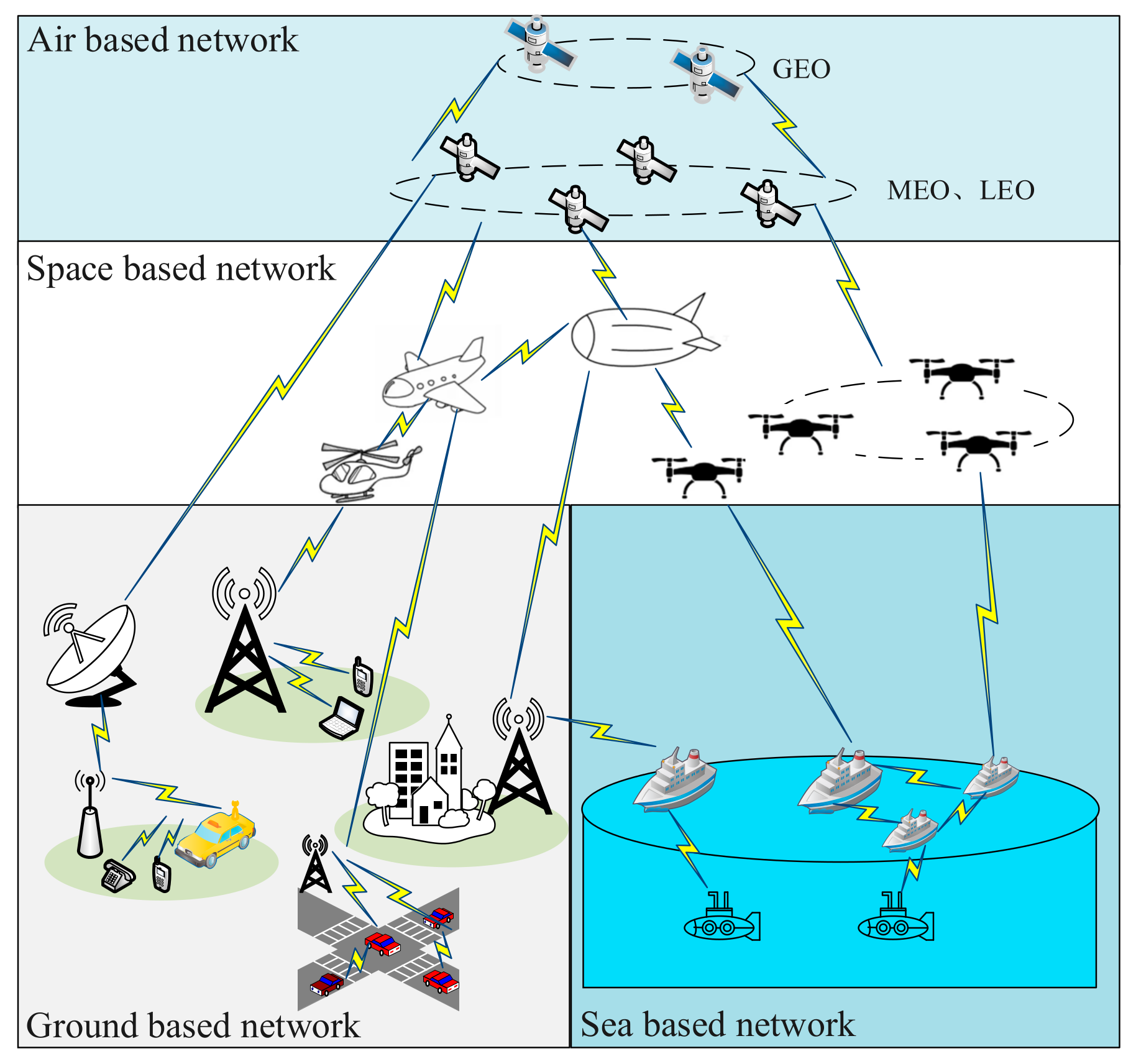
Figure 7. System topology of the space-air-ground-sea integrated emergency communication network.
网络技术支撑下,各地需要加快应急救援通信设备建设,特别是用于网络控制中心、卫星地面站、融合通信平台的设备。同时,还要利用应急通信设备扩大网络覆盖,推动应急救援工作的发展。